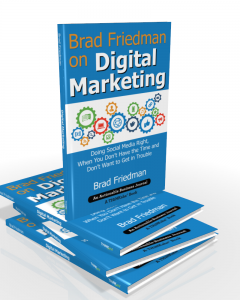In Part 1 we discussed how changes in technology have changed the way prospects look for professional service providers. Here, in Part 2 we will look at the strategies and social media tools prospects are using to find and hire professional service providers.
Search First, Call Later
The power of search engines like Google, Bing and Yahoo! enable prospects to search for professional service providers who are experts in the very narrow specialty area the prospect needs. If the financial services provider, for example, has carefully crafted his social media presence in a search engine optimized fashion that highlights his specific expertise, he is more likely to appear in the search results of a prospect. On the other hand, for example, if he simply lists his name and the name of his company in his profile on a particular social network, he is not likely to appear in search results.
When a prospect obtains a referral from a peer, he is likely to Google the referral and his firm to see what there is to see. He is likely to visit the firm’s website, check out the employee bios on the site and read any articles that appeared in the search results. He is also likely to search social networks like LinkedIn, Plaxo and YouTube, for information about the professional. If you or your firm don’t appear in the search results, you are not likely to get the call.
Content is King
Over the years, professional service providers have used public speaking and writing to develop their credibility in their particular specialty area. Like in the education field, many professionals live by the saying, “Publish or perish.” The tendency to speak and write is a good one, especially if one takes advantage of the power of social media to get the word out. Are you Tweeting about your upcoming speech to Rotary? Does your Facebook Status Update have a link to your most recent article in your professional journal?
When you provide quality information that happens to be on point for the issue affecting the prospect, the professional service provider builds credibility and trust while showcasing his expertise. This is true when that content is provided in a speech, in an article or on a social network platform.
Do You Have a Blog?
Google is the most used search engine and Google loves blogs. So, the best way to get your writing in front of prospects using Google, is to have a blog. Better yet, link your blog to your firm’s website and write each post using the keywords your prospects are likely using to search for you. Spend some time and money on search engine optimization. If you appear on the first page of a search you are more likely to get the call than not. If you appear at or near the top of that page, even better.
Here are some tips to help you build a successful blog:
- Post new material on a regular basis. I can’t stress enough how important this is. You must post something at least every week. When I visit a blog and see the most recent post was six months ago, I cringe and I’m likely to go to the next name that came up in the search.
I am a fan of what I call “Practice Area Blogs.” There should be a separate blog for the Litigation Department, the Tax Department, the Investment gurus and the Estate Planners. Group blogs work, but since prospects are searching in a particular specialty, you should present the material in that fashion.
Don’t be afraid to mix your original material with posts that reference other articles you’ve read and find helpful. Add a introduction or a critique to put your personal stamp on it. Don’t go overboard on references to other people’s work. Remember, you are trying to build your own reputation here.
Make sure your blog, like your firm’s website, contains all the disclaimers required by your particular profession. Put it at the bottom of the home page in a small font, but be sure to include it.
Spend the money to develop your brand and your professional image. Your blog should be branded like your firm’s website. A professional design goes a long way to help establish trust and credibility.
Let readers leave comments and engage in conversation with them, even if they disagree with you.
Use images when you can do so without violating copyright laws. Visit Getty Images and Creative Commons for resources.
Probably the most important tip of all is to be yourself. Find your own voice and use it. Show some personality. Let people get to know you. Showcase issues important to you and let your passion shine through.
Finally, choose a name for your blog that concisely describes what you are writing about and contains search engine friendly keywords.
In Part 3, we’ll discuss the use of Facebook, Twitter and LinkedIn to market yourself and your practice. Subscribe to our blog above on the right to be notified when the post appears or check back in several days.












